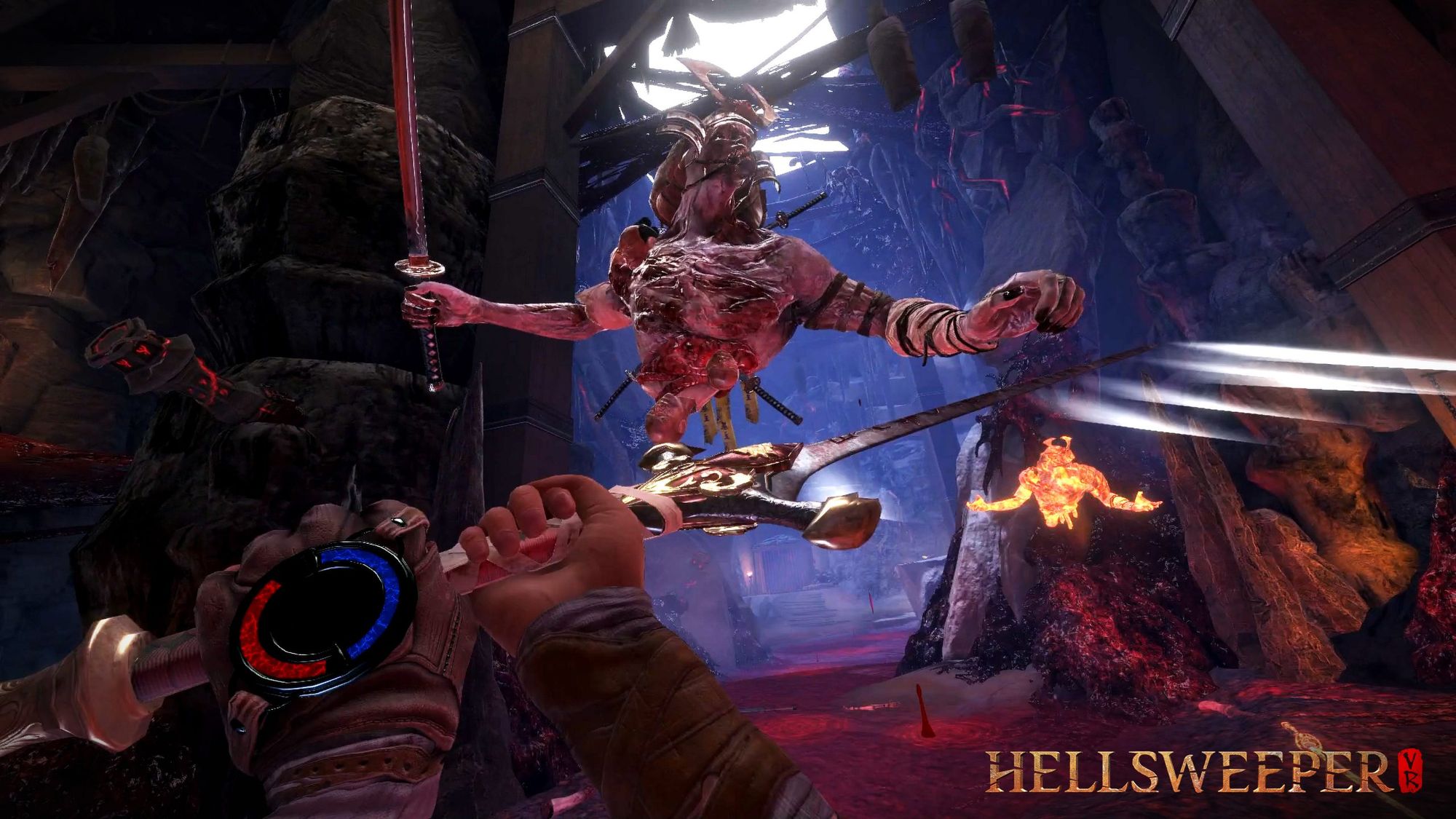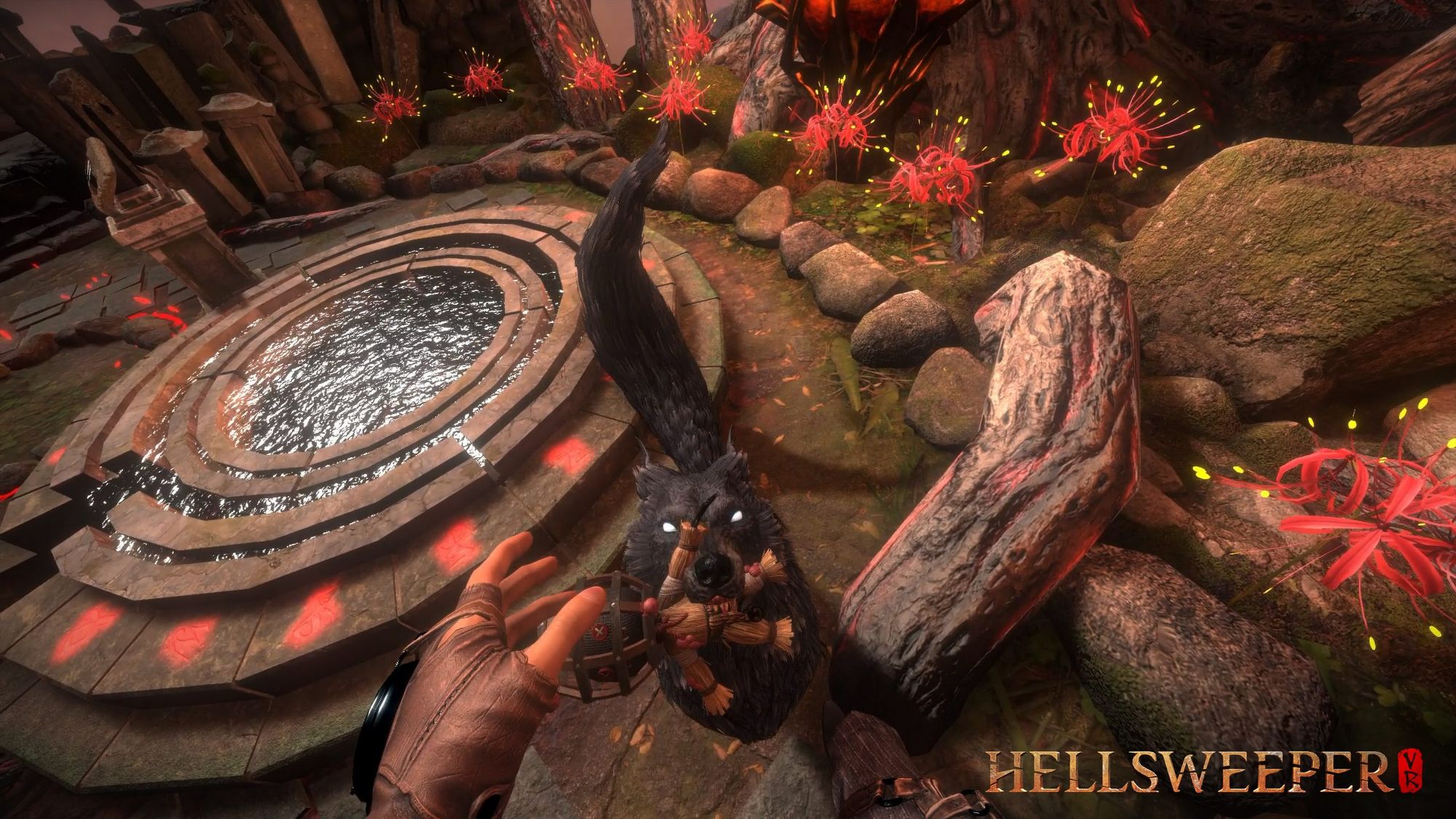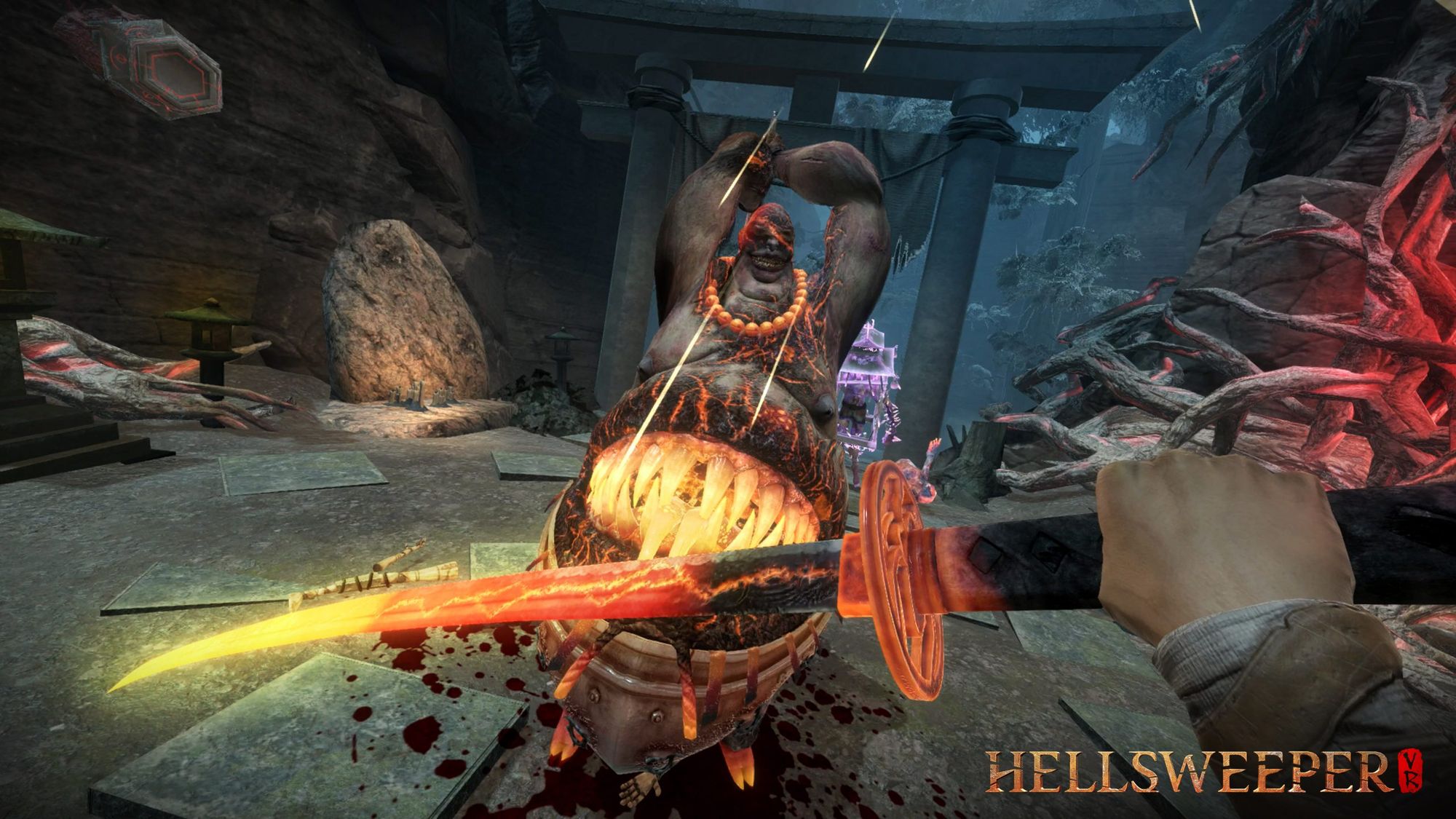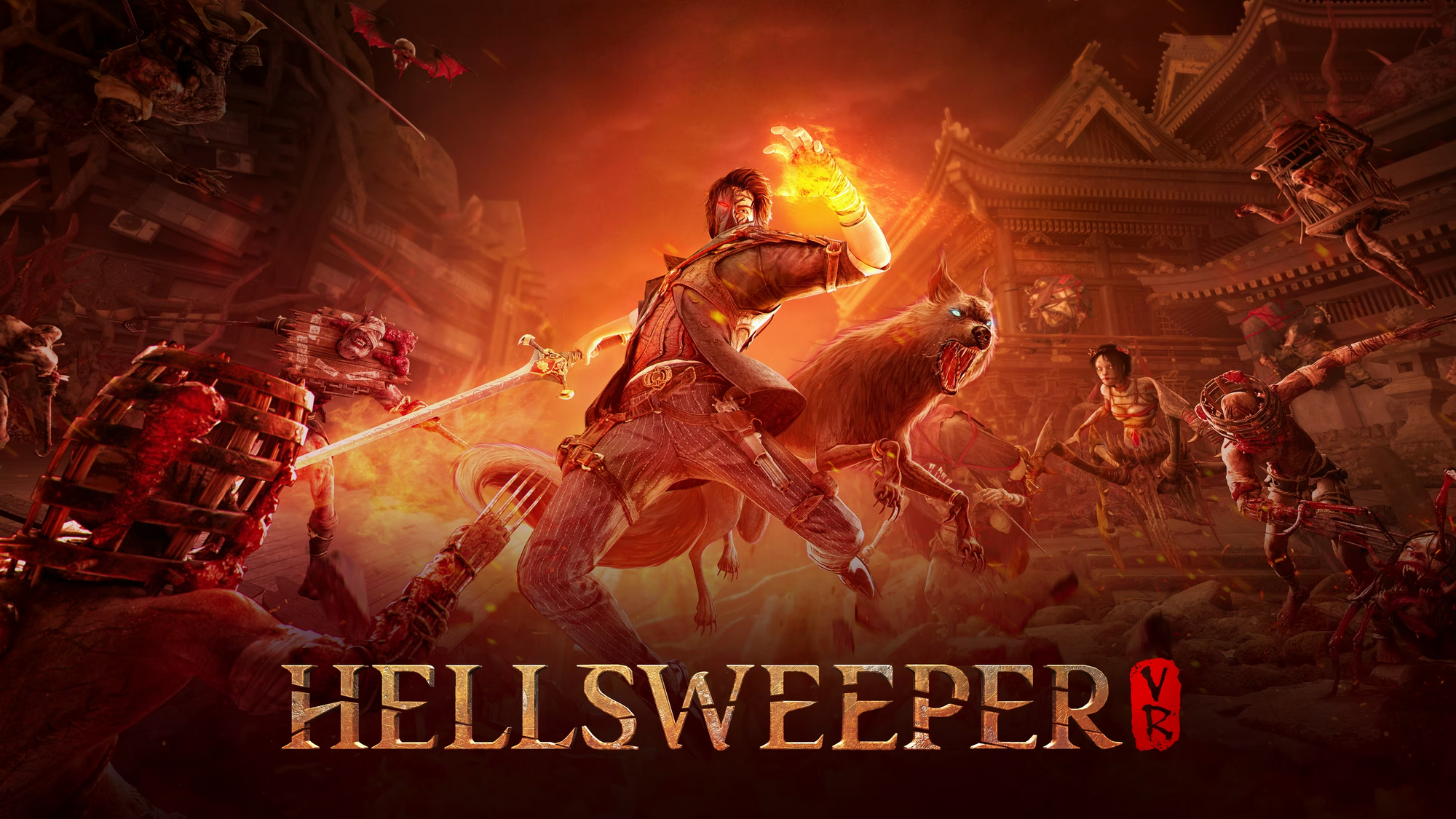Hellsweeper brings intense combat to Quest, PS VR2 and PC VR – here’s our full review.
There are two things to know about Hellsweeper right from the beginning: combat in Hellsweeper is intense, and Hellsweeper is built entirely around combat.
When Mixed Realms announced work on Hellsweeper, the studio’s second VR game, it seemed set to offer a combat experience unlike anything else in VR. Positioned as the spiritual successor to Cyber-Ninja slash-fest Sairento, it looked like a cocktail blend of Mortal Kombat, Sairento, Naruto and Airbender.
Now a few years on from that initial announcement, the wait is over and we can now backflip our way into the underworld to find out whether Mixed Realms’ second title measures up to expectations.
Platforms: Quest, PC VR, PSVR 2 (Review conducted on Quest 2)
Release Date: Out now
Developer: Mixed Realms
Price: $29.99
Clean Sweep
As with most roguelikes, Hellsweeper’s narrative is a fairly minimal affair. Hell has burst at its seams, threatening to spill into other realms. It’s up to the player to hold back the tide. You embody an undead immortal charged with the sacred duty of culling the demon overspill, a premise which adequately justifies the ensuing cycle of violence and rebirth.
Players battle through progressively tortured landscapes, brimming with seven deadly sins-inspired menaces. Each ‘sweep’ (the game’s name for a roguelike run) comprises of three acts, each including between four and seven combat scenes. Each scene presents a random combination of environments and mission types. While the variety of mission types could definitely use some expansion, the combat itself is addictively varied and thoroughly satisfying.
A sweep will culminate in a clash with one of the three monstrous bosses which, upon completion, unlocks new skills, traits, weapons and harder difficulty tiers. These harder difficulties in turn yield even greater rewards, unlocking even more goodies and perpetuating a cycle of escalating risk and reward.
Hella Good
Before beginning a sweep, players choose from a selection of randomly generated powers and weapons. These are each then assigned to one of four gestures, allowing them to be conjured at will.
From there, the game launches into a series of short action vignettes – a few minutes of chaos, violence and upside-down adrenaline that stands toe-to-toe with any other combat experience in the medium.
Like its spiritual forebear, Hellsweeper’s action is rooted in its ‘kitchen sink’ approach to game mechanics. From guns to swords, bows to magic, running on walls to doing slow motion backflips in mid-air – if you can think of a way to enact violence with it, Mixed Realms have probably got you covered.
The sheer range of options can actually be overwhelming at first. Early on, death is often caused by a bunny-in-headlights response to the sheer volume of things going on. But stick with it – soon it becomes clear that each of the myriad of mechanics has been implemented with care and skill. Within short order, you’ll be stringing together tightly choreographed carnage.

Hell Bent
Possibly Hellsweeper’s greatest strength lies in the options it gives players to change how the game plays across multiple sweeps. Most roguelikes rely on procedurally-generated map layouts for variety, while the core gameplay remains largely the same. However, the different weapons and skills available in Hellsweeper can change your approach entirely.
Starting with familiar weapons like a pistol or sword, you quickly find that switching between the two produces a vast difference in how you move through the scene. Alternating between two play styles on the fly becomes effortless and intuitive combat synergies start to emerge.
However, you may not be offered the same set of weapons for your next run, instead presented with a magic-based build. Everything previously learned becomes obsolete – a completely new playstyle is needed. Leaving the guns and swords behind, you’ll instead use gestures to hurl elemental forces around the environment or combine them together into powerful blasts that feel lifted straight from Dragon Ball Z.
The Gates of Hell
This versatility is both enhanced and hindered by the progression system.
Each sweep rewards the player with experience points, which over time will unlock the next level of goodies. This dangles the carrot, motivating players to grind out sweeps in the hope of unlocking items to keep the combat fresh.
The higher difficulty you play, the higher the rewards. This means that for casual players, progress is painfully slow – after 12 hours of play, for example, I had still only unlocked 25% of the game’s content. However, more skilled warriors who opt for harder difficulties will be able to achieve this far quicker.
Frustratingly, rewards are released in a strictly linear fashion based on XP – there is no ability to influence what unlocks next. Roguelikes will often allow the player to target specific perks with point systems, but a similar option is sorely missing here.
Given Hellsweeper leverages player agency almost everywhere else, locking all the coolest toys behind a linear grind is a bewildering decision. At a certain point, that carrot dangling in front of you will begin to rot and no doubt many will lose interest long before they’ve unlocked everything in the game.

I’ll Be Damned
In addition to the core roguelike mode, Hellsweeper also contains a sandbox-like Training Mode. This offers a space for you to fine tune your combat style, allowing you to bring specific loadouts to bear against a chosen variety and number of enemies.
There is also an unlockable Challenge Mode – though I still hadn’t unlocked the mode after 10+ hours of play, so I can’t comment on it from experience. Mixed Realms described the mode as designed to be “ultimate test of skills and is meant to be unfair,” supposedly dispatching a merciless range of adversaries while leaving you to defend yourself with limited resources. You’ll be able to compete for bragging rights in the mode, with both timed and scored leaderboards on offer.
Hellsweeper also includes a cross platform co-op multiplayer mode. Although a welcome addition, the multiplayer mode is slightly underdeveloped. Co-op play is limited to a single act with no option to play through a full, three act campaign with your partner. This ostensibly small criticism is only compounded by a feeling of missed potential – after a few tries at short co-op runs, they soon become unsatisfying.
Hell Hath No Fury
Hellsweeper’s visuals are decent, but hardly breathtaking.
The artistic direction is fantastic and there is some first-rate design work displayed throughout. Most of the environments drip with a sense of malice and foreboding, incorporating the verticality that the movement mechanics require in unique and characterful ways. Similarly, the character design is a study in malevolence, with grotesque enemies that match the tone and setting.
The only visual downfall is in areas where you can feel them pushing against the limitations of the hardware. We reviewed the game on Quest 2 and there are points where the game is presenting a litany of mechanics and impressive enemy count, but perhaps doing so at the expense of texture quality. The game never looks bad, but there’s sometimes a standalone mudiness to the visuals that you would hope isn’t present on more powerful platforms.
The sound design does a decent job of keeping up with the action, but lacks some refinement. Enemies don’t have distinctive sound cues that alert players of their presence, for instance, while spatial audio doesn’t do quite enough to pinpoint any specific position amongst the chaos. Crashland is a great example of how well delivered sonic components can become every bit as vital as the visuals – Hellsweeper would have benefitted from a stronger use of those techniques.
Editor’s Note – Hellsweeper PSVR 2 Visuals
Editor’s Note: This review was conducted on Quest 2 – the above passage reflects the visuals on that headset.
After launch, PlayStation players voiced concerns about Hellsweeper’s visuals on PSVR 2. Mixed Realms issued a statement confirming that, for a variety of reasons, render resolution was sacrificed on the PSVR 2 release. The studio promised visual updates are being worked on for both the Quest and PSVR 2 versions of the game. You can find more info here.
After briefly trying Hellsweeper on PSVR 2 ourselves, we can confirm that overall render resolution is quite low. The environments (and especially text) appear blurrier and muddier than expected for a console-powered VR title.
While our overall assessment of Hellsweeper’s gameplay, mechanics and structure still applies to all versions of the game, players should note that the visual presentation will be different across each platform.

(Dis)comfort
Hellsweeper’s ultra-intense gameplay is highly reliant on a range of artificial locomotion, the more advanced of which might even see VR veterans needing a lie down afterwards. There isn’t just smooth locomotion on the ground, but also intense and fast movement, such as artificial jumps, vertical movement, summersaults, backflips and more.
There is a robust suite of comfort options available, including snap turn, vignettes and teleport movement. Additionally, players can choose specific advanced movement features to disable, further tailoring their comfort needs.However, it should be noted that playing with more extreme comfort options significantly changes the nature of the gameplay. This is a game designed to sit at the far end of comfort as one of the most intense VR experiences available.
Hellsweeper VR Review – Final Verdict
Hellsweeper VR is a masterclass in virtual violence. For those with the stomach (or rather, the VR legs) for its unyielding intensity and a penchant for skipping straight to the action, Hellsweeper VR is unmissable – though it’s worth keeping in mind the visual differences between platforms, as our review playthrough was on Quest 2.
Filled with blistering battles that beg you to master a wide range of gameplay styles, it really is a hell of a good time.

UploadVR focuses on a label system for reviews, rather than a numeric score. Our reviews fall into one of four categories: Essential, Recommended, Avoid and reviews that we leave unlabeled. You can read more about our review guidelines here.





